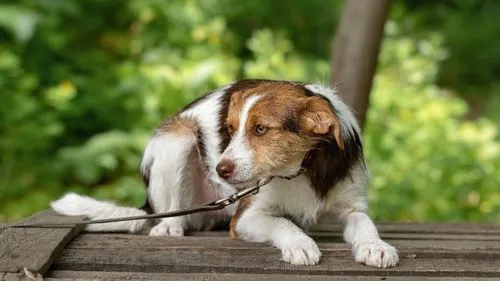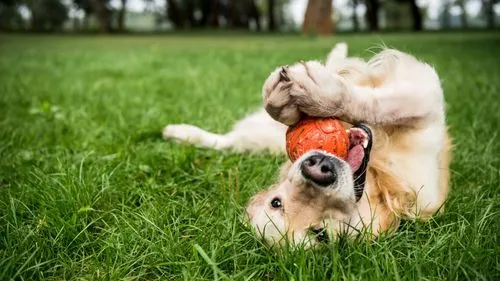Winter dog care: Tips for nutrition, comfort, exercise, and safety
January 06, 2025
Katka

There are two kinds of people, the ones that love winter and those who hate it and can’t wait to see the summer coming. It’s the same with dogs. Some of them can play in the snow for hours, and others are heading home after five minutes outside in cold weather. Either way, we have to pay more attention to dog care during the winter season. Winter weather requires special winter care for your beloved pet. In this article, you'll learn how to care for dogs in winter.
Feeding during winter season: Increased caloric needs
Winter conditions often necessitate a higher caloric intake for dogs, particularly those who are active outdoors. During the colder months, a dog's body must work harder to maintain its core temperature, leading to increased energy requirements.
Balanced diet tips for your canine companions
- Lean proteins: Incorporate lean meats like chicken, turkey, and fish into your dog's diet. These provide essential amino acids and are easily digestible.
- Healthy fats: Include sources of good fats, such as flaxseed oil or fish oil. These fats are crucial for maintaining energy levels and supporting a healthy coat.
- Temperature-adjusted food: Serving slightly warmed meals can be more appealing to dogs and can aid in digestion. However, ensure the food is only mildly warm to avoid any risk of burns.
- Comforting and nutritious: A warm meal can also provide a sense of comfort to your dog, making mealtime a soothing experience.
- Avoid overfeeding: While increased calories are necessary, it's important to avoid overfeeding. Monitor your dog's weight and adjust portions as needed.
It's always best to consult with a vet before making significant changes to your dog's diet, especially if your dog has specific health conditions.
Note: Attention should be given to dogs eating snow. The dog’s stomach doesn’t endure the cold snow well and can be irritated. Sometimes, however, this phenomenon means that the dog is thirsty.
Safety and comfort for dogs in winter
The colder months demand special attention to create a warm, secure, and humidity-controlled environment for our pets. This section will provide tips for outdoor dogs to ensure they are well-protected against winter's harsh elements.
Indoor dogs
- Cozy sleeping area: Ensure your indoor dog has a comfortable, draft-free place to sleep. An elevated bed with warm, soft bedding can help retain body heat and provide a snug resting spot.
- Room temperature: Maintain a consistent and warm room temperature in your home, especially in the areas where your dog spends the most time.
- Humidity control: Indoor heating systems can dry out the air, which might affect your dog's skin and respiratory system. Using a humidifier can help maintain a healthy level of humidity in your home, ensuring comfort for both you and your pet.
- Dog bathing: It is necessary to let the dog get dry after bathing. The change of temperature is difficult and can be dangerous so keep in mind to plan the bathing well.
Outdoor dogs
- Insulated dog house: Provide an insulated dog house that shields your dog from wind, snow, and rain. The house should be large enough for your dog to move around but small enough to retain body heat.
- Bedding and warmth: Very suitable is straw or wooden straw which has an excellent insulation effect and doesn’t remain wet. Never use blankets, old carpet, or fabric cushions. The cloth absorb moisture and subsequently become mouldy and cold or frozen and thus provides no insulation and it becomes trouble instead. Consider adding a safe, pet-friendly heating source for extra warmth.
- Access to water: Ensure that your dog has access to fresh, unfrozen water at all times. Heated water bowls can prevent water from freezing in cold temperatures.

Exercise and mental stimulation for dogs in winter
As temperatures drop and outdoor conditions become more challenging, it's crucial to adapt our approaches to ensure our dogs remain active, engaged, and safe. This section explores effective strategies for indoor activities, tips for safe outdoor exercise, and methods to maintain your dog's mental well-being during the colder months.
Activities for your dog
- Interactive play: Engage your dog with puzzle toys or hide-and-seek games. These activities stimulate their mind and keep them physically active.
- Training sessions: Use this time for obedience training or teaching new tricks. Indoor training can be both mentally stimulating and a great way to strengthen your bond. You can also train your dog when you are not at home, using Barkio dog monitor app. You can record your own commands and use it remotely.
- Shorter, frequent walks: In colder months, opt for shorter but more frequent walks to ensure your dog gets enough exercise without being overexposed to the cold.
- Play in snow: If your dog enjoys snow, allow some playtime in a safe, open area. Monitor them for signs of cold or discomfort.
Avoid hazards: Steer clear of icy patches to prevent slips. Use dog boots or paw protectants if walking on salted roads.
Mental well-being
- Consistent routine: Maintaining a regular exercise schedule helps your dog's mental health, preventing winter-related anxiety or depression.
- Social interaction: If possible, arrange playdates with other dogs. Social interaction is crucial for your dog's mental well-being.
- Monitoring of your dog: When keeping your dog alone for a long time, make sure he's well and not mentally wasting away. You can do this with the Barkio app, which you can download for free so you never have to worry about your dog again.

Dog clothing and paw protection in winter
One of the key areas of concern is the protection of our furry friends from the cold and harsh elements. Some dogs are not adapted to the cold weather and need some help during the winter season. Dog clothes certainly help and they should be part of the winter dog care routine.
Importance of dog clothing
- Warmth and comfort: Dog clothing, like sweaters and coats, is essential in winter, especially for breeds with short fur. They provide extra warmth and shield against cold winds.
- Safety: Reflective clothing is beneficial for visibility during short daylight hours in winter.
- Paw protection: In winter, dogs' paws are exposed to salt, grit, and ice, which can lead to dryness, cracks, and even chemical burns.
Ensuring your dog is well-equipped with appropriate clothing and paw protection is key to their well-being and safety during winter months. This topic is very extensive and therefore we devote a whole article to it. Find out more about how to dress your dog in winter and how to care for your dog's paws.

Health check-ups and preventative care for dogs in winter
As winter sets in, the need for diligent health check-ups and preventative care for our canine companions becomes more crucial. The colder months can bring about unique health challenges for dogs, including exacerbated chronic conditions and the potential for winter-specific illnesses.
- Regular veterinary visits: Regular veterinary check-ups are essential to monitor and manage any health issues that may be exacerbated by the cold weather. These visits allow for the early detection and treatment of any new health problems that may arise during the winter months.
- Vaccinations and parasite control: Ensure your dog's vaccinations are up to date. Some diseases can be more prevalent in the winter, making vaccinations a critical part of preventative care. Also, contrary to popular belief, fleas and ticks can survive indoors during winter. Continue your dog's flea and tick prevention regimen throughout the season to protect them from these pests.
Frequently asked questions
1. Why do dogs need increased calories in winter?
In winter, dogs require more energy to maintain their core temperature, necessitating a higher caloric intake, especially for active outdoor dogs.
2. What are some diet tips for dogs during winter?
Include lean proteins like chicken and fish, healthy fats such as flaxseed or fish oil, and serve slightly warmed meals. Also, avoid overfeeding and consult a vet for diet changes.
3. Is it safe for dogs to eat snow?
Eating snow can irritate a dog's stomach. It can also indicate that the dog is thirsty.
4. How should I care for indoor dogs in winter?
Provide a cozy, draft-free sleeping area, maintain a warm room temperature, control indoor humidity, and ensure the dog is dry after bathing.
5. What are the essentials for outdoor dogs in winter?
Provide an insulated dog house, suitable bedding like straw, access to unfrozen water, and consider a pet-friendly heating source.
6. How can I keep my dog active and mentally stimulated in winter?
Engage in interactive play, conduct indoor training sessions, opt for shorter, frequent walks, and ensure regular exercise and social interaction.
7. What kind of clothing and paw protection do dogs need in winter?
Dogs may need sweaters or coats for warmth, reflective clothing for safety, and paw protection against salt, grit, and ice.
8. Why are health check-ups important for dogs in winter?
Regular veterinary visits help monitor health issues that could worsen in cold weather and ensure vaccinations and parasite control are up to date.
Conclusion
Remember, the key to a happy and healthy dog during winter lies in being proactive and attentive to their needs. Regular vet check-ups, appropriate winter attire, and a warm and loving environment go a long way in safeguarding their health and happiness. By following the guidelines outlined in this article, you can ensure that your furry friend enjoys the winter season as much as you do, keeping the cold at bay with the warmth of your care and attention.
Continue reading...
Show all articlesCopyright & trademark notices
Apple, the Apple logo, and iPhone are trademarks of Apple Inc., registered in the U.S. and other countries and regions. App Store is a service mark of Apple Inc. Mac App Store is a service mark of Apple Inc. Google Play and the Google Play logo are trademarks of Google LLC. Windows® and the Windows logo are either registered trademarks or trademarks of Microsoft Corporation in the United States and/or other countries. Linux® is the registered trademark of Linus Torvalds in the U.S. and other countries.


